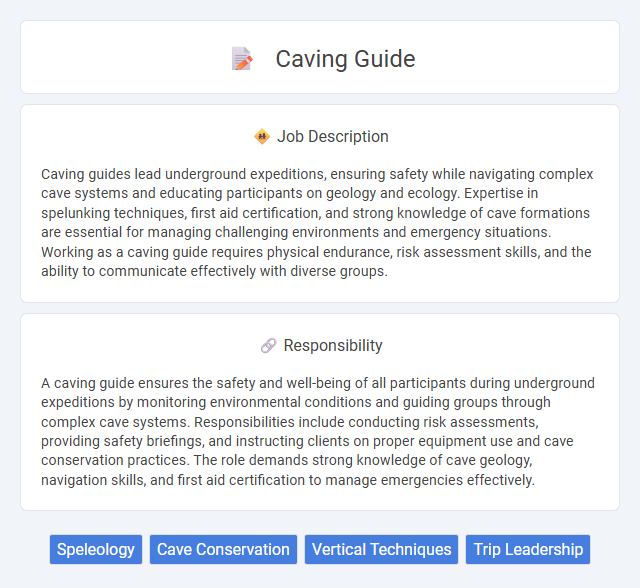
Caving guides lead underground expeditions, ensuring safety while navigating complex cave systems and educating participants on geology and ecology. Expertise in spelunking techniques, first aid certification, and strong knowledge of cave formations are essential for managing challenging environments and emergency situations. Working as a caving guide requires physical endurance, risk assessment skills, and the ability to communicate effectively with diverse groups.
Individuals with a strong sense of adventure and physical fitness are likely to be well-suited for a caving guide job, as it often requires navigating challenging underground environments. Those prone to claustrophobia, vertigo, or lacking endurance may face difficulties in this role due to the confined spaces and demanding physical activity involved. The probability of success increases with good problem-solving skills, a calm demeanor under pressure, and the ability to ensure group safety in potentially hazardous conditions.
Qualification
Caving guide positions demand strong knowledge of spelunking techniques, safety protocols, and geology, supported by certifications such as Wilderness First Aid or CPR. Experience in navigating complex cave systems and proficiency with climbing equipment are essential to ensure visitor safety. Candidates often require excellent communication skills and physical fitness to lead groups through challenging underground environments efficiently.
Responsibility
A caving guide ensures the safety and well-being of all participants during underground expeditions by monitoring environmental conditions and guiding groups through complex cave systems. Responsibilities include conducting risk assessments, providing safety briefings, and instructing clients on proper equipment use and cave conservation practices. The role demands strong knowledge of cave geology, navigation skills, and first aid certification to manage emergencies effectively.
Benefit
Working as a caving guide likely offers significant benefits including opportunities to explore unique underground environments and develop specialized skills in navigation and safety. The role probably enhances physical fitness and provides a sense of adventure, attracting individuals who enjoy challenging and dynamic work settings. Income from guiding tours combined with potential tips may offer reasonable financial rewards, alongside the chance to educate others about geology and natural history.
Challenge
A caving guide job likely involves navigating complex underground environments that present both physical and mental challenges, requiring strong problem-solving skills and adaptability. The role probably demands managing uncertain conditions such as tight spaces, unpredictable terrain, and limited visibility, which can test one's resilience and decision-making. Success in this position might depend heavily on the ability to remain calm under pressure and ensure the safety of the group while exploring demanding cave systems.
Career Advancement
Caving guide careers offer strong advancement opportunities through certifications in advanced spelunking techniques and leadership training, enabling guides to lead more complex expeditions and manage larger groups. Experienced guides often transition into roles such as expedition coordinators, safety instructors, or adventure tourism managers, increasing earnings and industry influence. Building expertise in geology, first aid, and environmental conservation further enhances prospects for promotion and specialization within the outdoor adventure sector.
Key Terms
Speleology
A caving guide specializing in speleology leads expeditions through cave systems, ensuring safety while exploring geological formations and underground ecosystems. Expertise in mapping cave passageways, identifying mineral deposits, and understanding hydrology is essential for guiding both novice and experienced spelunkers. Proficiency in rope techniques, emergency response, and environmental conservation principles supports sustainable exploration in fragile subterranean environments.
Cave Conservation
Caving guides play a critical role in promoting cave conservation by educating visitors about fragile cave ecosystems and minimizing human impact. They implement safety protocols and sustainable caving practices to protect unique geological formations and endangered species within caves. Expert knowledge of local cave systems and conservation regulations ensures that tours are both informative and environmentally responsible.
Vertical Techniques
Caving guides specializing in vertical techniques possess expert skills in rappelling, ascending ropes, and rigging systems to safely navigate deep subterranean passages. Mastery of equipment such as harnesses, carabiners, and descenders is essential for ensuring climber safety during vertical descents and ascents. These professionals also conduct thorough risk assessments and deliver precise instructions to facilitate secure exploration of vertical cave environments.
Trip Leadership
Caving guides specialize in trip leadership by ensuring safe navigation through underground cave systems while managing group dynamics and environmental preservation. They conduct thorough risk assessments, provide expert instruction on caving techniques, and maintain communication to adapt to changing conditions within the cave. Effective trip leadership enhances participant safety, fosters teamwork, and preserves the delicate cave ecosystem.
 kuljobs.com
kuljobs.com